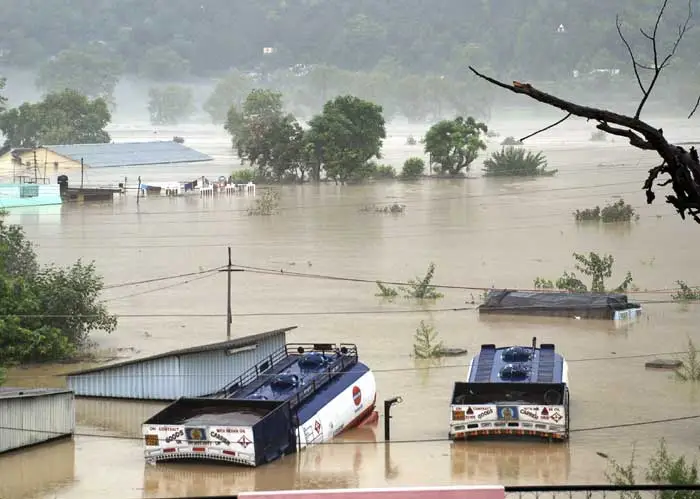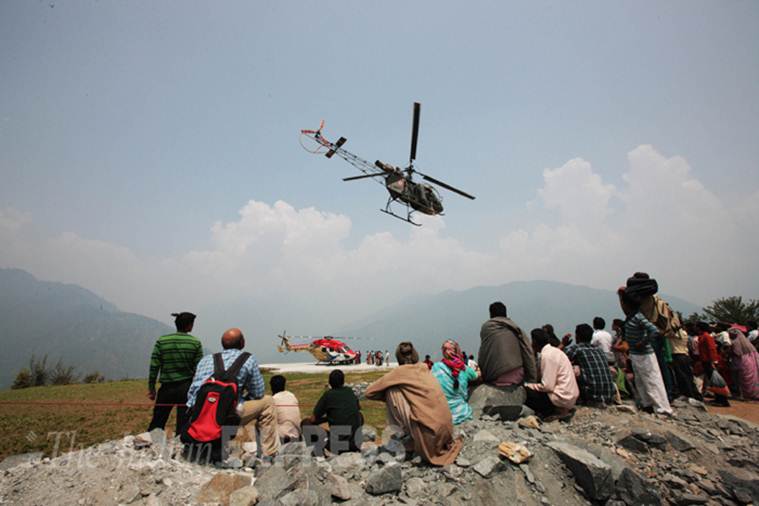- India
- International
Here is what happened in Kedarnath, and rest of Uttarakhand, in 2013
Between June 13 and 17, the state of Uttarakhand had received an unusual amount of rainfall. This led to the melting of the Chorabari glacier and the eruption of the Mandakini river.
 Five years later, film maker Abhishek Kapoor is out with a film that tells the story of the devastating flood that left Uttarakhand in shreds. (Express photo)
Five years later, film maker Abhishek Kapoor is out with a film that tells the story of the devastating flood that left Uttarakhand in shreds. (Express photo)
In the early hours of June 17, 2013 a flash flood came down upon the overflowing banks of the Chorabari lake in Uttarakhand. Carrying huge amounts of silt and rocks, it destroyed lives, houses and everything else that came its way. Five years later, film maker Abhishek Kapoor is out with a film that tells the story of the devastating flood that left Uttarakhand in shreds. Kedarnath, starring actors Sushant Singh Rajput and Sara Ali Khan, is a romantic drama set in the backdrop of the 2013 floods. The story revolves around a wealthy Hindu girl who is on pilgrimage at the Kedarnath temple, considered to be one of the sites at the Chhota char dham Hindu pilgrimage in the northern Himalayas, and a Muslim guide.
The film has been mired in controversy over the projection of an inter-faith love story. As it readies to hit the silver screen on December 7, here is a look back at the episode that shook the hilly state, leaving thousands dead and several others missing.
What exactly had happened?
Between June 13 and 17, the state of Uttarakhand had received an unusual amount of rainfall. This led to the melting of the Chorabari glacier and the eruption of the Mandakini river. The floods affected large parts of Uttarakhand, Himachal Pradesh and Western Nepal. The heavy rainfall caused massive flash floods and landslides resulting in the death of residents and tourists as well as extensive damage to property. Reportedly the worst hit was the Kedarnath valley popular for the 8th century temple dedicated to Lord Shiva. The flood left behind a death toll of more than 5000. Ecologist Chandra Prakash Kala notes in a report that “the approximate cost of damaged bridges and roads was $285 million, dam projects worth $ 30 million and loss to state tourism worth $195 million.”
 Between June 13 and 17, the state of Uttarakhand had received an unusual amount of rainfall. This led to the melting of the Chorabari glacier and the eruption of the Mandakini river. (AP photo)
Between June 13 and 17, the state of Uttarakhand had received an unusual amount of rainfall. This led to the melting of the Chorabari glacier and the eruption of the Mandakini river. (AP photo)
The upper Himalayan regions of Himachal Pradesh and Uttarakhand are difficult to access due to the difficult snow-clad terrain. But a good number of pilgrims make the trip every year thanks to its religious sites. Uttarakhand, in fact, has four Hindu temples — Badrinath, Kedarnath, Gangotri, Yamunotri — and one Sikh shrine — Hemkund Sahib — that bring in thoudands of pilgrims every year.
Kala notes that in 2011 approximately 25 million tourists had visited the area despite the fact that the region is highly susceptible to natural disasters like earthquakes, landslides and flash floods. Historical records shows the area had been affected by similar natural disasters back in 1893, 1968 and in 1970 when the calamitous impact of the flood had resulted in the Chipko movement.

What was the cause of the flood?
Despite the fact that heavy rainfall and cloudbursts are natural causes for the floods and landslides, environmentalists believe that the disaster of 2013 was a manmade one. “Unplanned and haphazard construction, mismanaged tourism and related activities including intensive mining in this fragile ecosystem are some of the reasons that made to name this natural disaster partly as man-made that increased the intensity and magnitude of damages,” writes Kala. Over the years the number of pilgrims visiting the area had also exponentially increased. In order to meet with the rising demands of religious tourism, the state government built an intricate network of roads, hotels, lodges and carried out other construction activities into the remote mountainous regions of the Himalayas. However, it is also true that the unexpected timing of the rainfall and the unusual amount of it also did not leave enough time for the pilgrims to evacuate, thereby increasing the magnitude of the impact.
How was the relief work carried out?
The relief work was carried out by a combined team of army, airforce, navy, Indo-Tibetan Border Police (ITBP), Border Security Force, National Disaster Response Force (NDRF), Public Works Department as well as by local administration. Within five days, the army had deployed about 10,000 soldiers and the airforce had brought in more than 45 pieces of aircraft to carry out the rescue operation. The ITBP which guards the Indo-China border swung into action even before the army or the air force could reach the spot. They apparently managed to rescue more than 33,000 people from remote, inaccessible mountain zones. It is worth noting that after the disaster, the rescue operation in the region in itself has become a risky affair due to the unpredictable weather conditions, mountainous topography and lack of accessibility in majority of the routes.
 The relief work was carried out by a combined team of army, airforce, navy, Indo-Tibetan Border Police (ITBP), Border Security Force, National Disaster Response Force (NDRF), Public Works Department as well as by local administration. (Express photo)
The relief work was carried out by a combined team of army, airforce, navy, Indo-Tibetan Border Police (ITBP), Border Security Force, National Disaster Response Force (NDRF), Public Works Department as well as by local administration. (Express photo)
In the aftermath of the disaster, the fear among pilgrims resulted in a severe blow to tourism, which is a major source of income for most of the local inhabitants of the place. The Nanda Devi Raj Jaat which is a most important festival in Uttarakhand that takes place every 12 years was scheduled to take place on August 29, 2013. However, the state government was forced to cancel it on account of the damage caused to roads and bridges. After 100 days of deafening silence the pilgrimage route to Kedarnath was finally opened on October 5, but only a small number of pilgrims were allowed at a time. However, religious tourism continued to remain affected for the next couple of years. It is worth noting though that despite the damage caused and the fear instilled by the floods, faith of the pilgrims was restored when they realised that though most parts of Kedarnath town had undergone a catastrophe, what remained untouched was the Shiva temple built in the 8th century AD.
May 15: Latest News
- 01
- 02
- 03
- 04
- 05





























